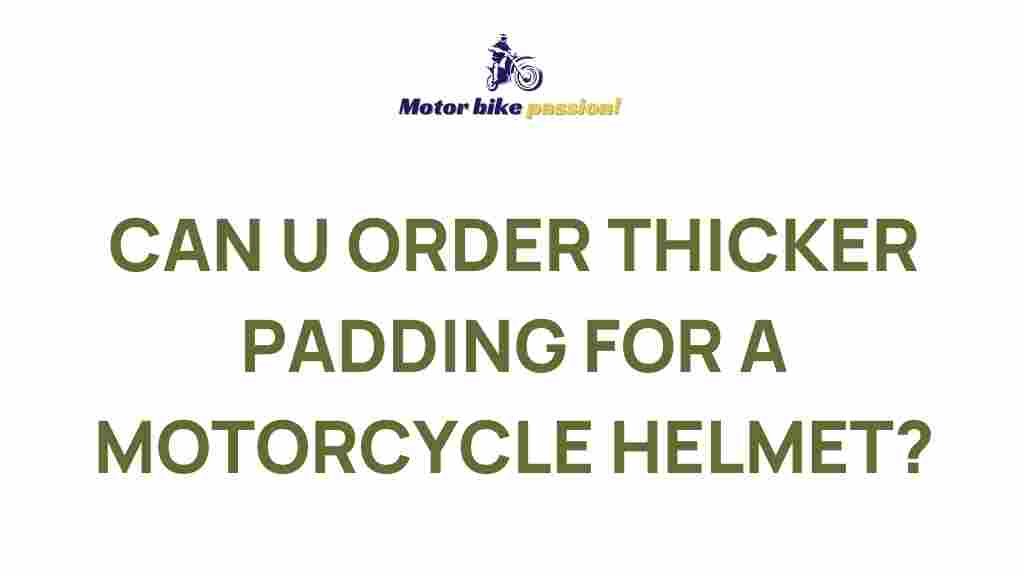Unveiling the Secrets to Customizing Your Motorcycle Helmet
When it comes to motorcycle safety, the importance of a quality motorcycle helmet cannot be overstated. Not only does it protect your head in case of an accident, but it also contributes to your overall riding experience. Customizing your motorcycle helmet allows you to enhance its comfort, design, and safety features. In this article, we will explore the various ways you can personalize your motorcycle helmet, focusing on customization options such as padding, design, and comfort.
Why Customize Your Motorcycle Helmet?
Customizing your motorcycle helmet is not just about aesthetics. It involves enhancing safety, comfort, and personal expression. Here are a few reasons why you should consider customization:
- Safety: Improved fitment can enhance protection.
- Comfort: Custom padding can prevent discomfort during long rides.
- Design: Unique designs allow riders to express their individuality.
- Personalization: A customized helmet can reflect your style and personality.
Step-by-Step Process for Customizing Your Motorcycle Helmet
Customizing your motorcycle helmet involves several steps, from selecting the right base helmet to adding personalized touches. Here’s a detailed guide to help you through the process:
1. Choose the Right Motorcycle Helmet
Before diving into customization, it’s essential to select a quality motorcycle helmet that fits well. Consider the following:
- Safety Ratings: Look for DOT or Snell certification.
- Fit: Ensure the helmet fits snugly without being uncomfortable.
- Type: Decide between full-face, modular, or open-face helmets based on your riding style.
2. Select Your Customization Options
Once you have your base helmet, you can choose from various customization options:
- Padding: Upgrade the internal padding for better comfort. Consider materials that wick moisture and provide cushioning.
- Graphics and Paint: Personalize your helmet’s exterior with custom paint jobs or vinyl wraps.
- Accessories: Add visors, sun shields, or communication systems to enhance functionality.
- Decals and Stickers: Apply decals that reflect your personality or interests.
3. Enhance Safety Features
Customization is also an opportunity to enhance safety features:
- Reflective Material: Incorporate reflective stickers or paint to increase visibility at night.
- Impact-Absorbing Liner: Consider upgrading to a helmet with advanced impact-absorbing materials.
- Skull Cap Inserts: These can provide additional protection and comfort.
4. Focus on Comfort
Comfort is crucial for long rides. Here are ways to ensure your helmet feels great:
- Custom Padding: Use custom-fit padding that conforms to the shape of your head.
- Ventilation: Ensure the helmet has adequate vents for airflow, reducing heat buildup.
- Weight: Choose lightweight materials to decrease neck strain during long rides.
5. Final Touches and Personalization
Now that you have made adjustments to safety and comfort, it’s time for personalization:
- Color Scheme: Choose a color scheme that matches your bike or personal style.
- Custom Artwork: Hire an artist to create a unique design that tells your story.
- Monograms or Initials: Add your initials for a personal touch.
Troubleshooting Common Customization Issues
While customizing your motorcycle helmet can be a fun process, you may encounter some challenges. Here are some common issues and tips to troubleshoot them:
1. Discomfort After Customization
If your helmet feels uncomfortable after adding new padding or accessories, try the following:
- Check the fit of the padding to ensure it’s not too thick or too tight.
- Remove any unnecessary accessories that may be causing pressure points.
- Consider using removable padding that you can adjust based on your comfort level.
2. Reduced Visibility from Graphics
Sometimes, custom graphics can obstruct your view. To solve this:
- Ensure that graphics do not cover the visor area.
- Use transparent vinyl for graphics that need to be placed near the eye level.
- Test visibility in various lighting conditions before finalizing designs.
3. Helmet Becoming Too Heavy
If adding accessories makes your helmet too heavy, consider these tips:
- Opt for lighter materials for any additional accessories.
- Evaluate the necessity of each accessory; remove those that are not essential.
- Balance the helmet’s weight by evenly distributing accessories on both sides.
Conclusion
Customizing your motorcycle helmet is a great way to enhance your safety, comfort, and style. By focusing on the right padding, design, and personalization, you can create a helmet that truly reflects who you are while ensuring you stay protected on the road. Remember to keep safety as your priority, and enjoy the process of making your motorcycle helmet uniquely yours.
For more information on motorcycle safety and gear, check out resources like NHTSA Motorcycle Safety. And if you’re looking for helmet customization services, visit our partners here for more options.
This article is in the category Gears and created by MotorBikePassion Team
